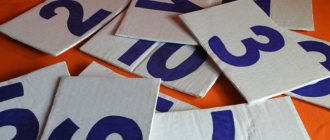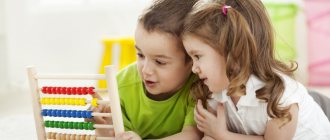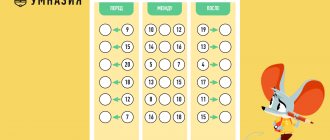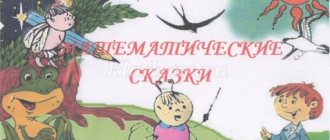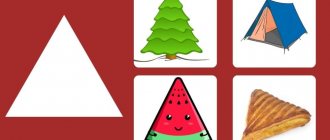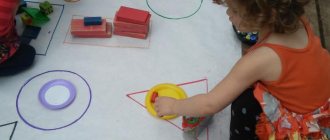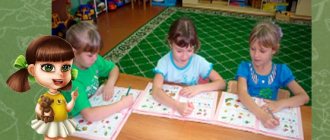Summary of a lesson on the formation of elementary mathematical concepts on the topic: “Oval”
Attached to each carriage is a card with a picture made up of geometric shapes drawn on the tickets:
— I am a cashier at a railway ticket office. Each of you will receive a ticket. Then you need to find your carriage. To do this, take a close look at your tickets. If you find the same geometric shapes on the carriage, then this carriage is yours.
While the children are looking for their seats, the teacher takes on the role of conductor (puts on a cap, takes a bag, attaches a badge). The children get into their carriages.
— Has everyone taken their seats? (Yes).
- Now I am a conductor. Show your tickets.
The teacher checks the “tickets”.
Subtotal:
Well done guys, everyone managed to get on the train because they correctly identified the geometric shapes. We can go.
The audio recording “Knock of Wheels” is played.
- Guys, we've arrived!
3. Difficulty in a game situation.
Goal: organizing an analysis by children of the situation that has arisen, leading them to identify the location and cause of the difficulty.
Requirements:
- creating a situation of difficulty;
- fixation in speech of the cause of the difficulty.
Children are “met” by the inhabitants of the country of Geometric shapes (triangle and square). Under the magnet next to them is a piece of paper with a task.
— Guys, do you think the inhabitants of the country of Geometric Shapes are happy to see us? (Yes).
- How did you guess? (They smile at us).
- Of course, the residents are happy, because you came to help them!
- Let's ask the residents how to help them! (The children ask, but the circle and square are silent).
- Learned? (No)
— How do you know how to help residents? (Guess), (See for yourself what needs to be done), (Read what is written in the note).
The teacher reads the note:
“Put things back where they belong, in boxes.”
Game "Putting objects in place"
The children sit at the tables. On the tables there is a “box” (a large circle) and “things” - round-shaped objects: a wheel, a watch, a plate, a coin, a tray, a sponge, a steering wheel, cookies, a steering wheel, a CD, a cutting board, a lifebuoy. The size of the small circles is such that they fit into an oval. There are also oval-shaped objects according to the number of children - a watch, a mirror, a piece of bread, a tray, a plate, a sponge, a napkin, a wooden cutting board, a plastic cutting board, a rug.
— What shape is the box? (Round).
- This means that round objects must be put in it.
— Put these items in the box. (the teacher points to a circle cut out of a landscape paper)
Children place round objects in a circle, but cannot place oval objects.
— Are all things in place now? (No).
—You couldn’t put all your things away? (Failed).
- Why? What's the problem? (There are things that are not round, the mirror does not fit into the box).
- Why can't we put these things in a round box? (Because it is of a different shape; the napkin is not round).
“You couldn’t remove all the things and help the residents.”
The teacher pauses long enough for the children to comprehend the situation of difficulty.
—Are you in a difficult situation? (Yes).
- Discovery of new knowledge.
Goal: organizing a dialogue between the teacher and children aimed at discovering new knowledge.
Requirements:
- organizing an introductory dialogue in order to discover new knowledge;
- fixation of new knowledge in speech and symbolically;
- creating a situation of success.
Game "Find the box"
- What do we do? (Let's pick a box for these items).
If the children find it difficult, the teacher continues the introductory dialogue:
— You put round objects in a round box. Items that you were unable to remove have a different shape. Can you find a suitable box for it? (Yes).
- Pick it up.
Children go to another table, on which there are squares, triangles, circles and ovals cut out of colored cardboard. There are as many ovals as there are children.
— Guys, choose a suitable box and put the items in it.
Children choose the desired “box” and sit down.
— Now all the items are put away in boxes? (Yes).
- Count how many round objects you have? (Four).
— How many non-round objects do you have? (One).
Subtotal:
Well done, you managed to tidy up because you picked suitable boxes for both round and oval items.
The teacher tells the children that the inhabitants of the country of Geometry thank them and give them a gift - a box with ovals. Children each take an oval,
The teacher hangs an oval on the board.
- Do you want to play with them? (Yes)
- Look at the oval.
- Circle it with your finger (children circle the oval).
-What did you notice? (an oval has no corners)
- What other figure does not have corners? (at the circle)
— How does an oval differ from a circle (an oval is elongated, and a circle is smooth)
We know that the circle rolls well (the teacher shows how the circle rolls)
— Try to roll an oval (children roll an oval).
— The oval also rolls well (no).
- Let's hide the oval (children “hide” the oval under a sheet of paper)
The teacher shows the ellipsoid.
- Is this an oval? (Not really)
- Let's try to hide it (the children are trying to hide the ellipsoid under a sheet of paper).
— Did you manage to hide this figure? (No)
- That's right, this figure is not an oval, an oval is flat.
The teacher points to the oval.
- Here is an oval - it is flat, elongated, without corners.
Summary: Well done guys, you understand what an oval is.
5. Inclusion of new knowledge into the knowledge system.
Goal: consolidate new knowledge in children through games and exercises.
Requirements:
- compliance of the games used with the purpose of the lesson;
- individual difficulties in games;
- situation of success in joint activities.
A rectangle appears with a sad face on it. He has a note.
— Another resident came to us. What do you think is his mood? (he is sad, cheerless)
- Ask why he is so sad?
- Why are you so sad?
(The children ask, but the rectangle is silent.)
- Learned? (No)
- How to find out? (Guess, read what is written in the note).
The teacher reads the note:
“I lost oval objects because I was lazy and didn’t put them back in their place.”
- Don’t worry about the rectangle, our guys will help you.
- Guys, can you help? (Yes)
Game "Collect objects"
The teacher is holding an oval-shaped box in his hands.
- Look carefully around, find all the oval-shaped objects in our group and bring them to this box.
Children look for oval objects laid out everywhere in a group (mirror, rug, sponge, napkin, etc.)
Subtotal:
Well done boys. You completed the task and found all the lost oval objects.
When children find all the oval objects, they give the box to the rectangle. The rectangle has a joyful face. He has a note.
- Look, guys, another note. Let's read it.
The teacher reads the note:
"Thank you guys. I will never throw my things around again. Because you helped me, I want to give you a cartoon.”
Children watch the cartoon "Geometric Shapes".
— Guys, did you like the rectangle gift? (Yes)
“Now it’s time for us to go back to kindergarten.” Take your seats on the train.
The sound of wheels sounds in the recording, the children return to kindergarten.
- Summary of the lesson.
Goal: organizing reflection and self-assessment of children’s activities.
Requirements:
- organization of analysis of children's goals;
- fixation of new knowledge in speech;
- determining the fulfillment of an adult goal.
Children sit on chairs.
- Guys, where were we today? (in the country of Geometry)
- Why did we go there? (help residents clean up)
— Were we able to help the inhabitants of the country of Geometry? (Yes)
- Why did you succeed? (we know geometric shapes, we know colors, we can count, we are kind)
- What geometric shape did we meet today? (oval)
“We completed all the tasks because we know geometric shapes, we know colors, we can count, because we are attentive, kind guys. Well done!
FEMP lesson notes “Meet me Oval!”
ABSTRACT
GCD
ON THE FORMATION OF ELEMENTARY MATHEMATICAL CONCEPTS ON THE TOPIC: “MEET ME, I’M AN OVAL.”
Second junior group
HELD
TEACHER 1 CATEGORY
LYUBAEVA O.V.
KINDERGARTEN "ROSINKA"
Goals
: give children an idea of an oval; exercise the ability to classify geometric shapes according to two characteristics (shape and color); continue to develop spatial orientation skills; consolidate ordinal counting up to 4, the ability to indicate the number of objects with a number; develop logical thinking.
Demo material
: flannelgraph, circle, triangle, square, oval-puddle (blue), circle-sun (yellow), pictures: little fox, tomato, carrot, cucumber; “house for figures” (the square is divided into 4 cells horizontally and 4 vertically; on top of each cell there is a graphic representation of geometric shapes: circle, square, triangle; colors are indicated on the left: red, blue, yellow); a screen, two trees of different heights, four birds, four numbered envelopes, three butterflies, two red and green bags, a bunny (toy), a beautiful oval for an entertaining mathematics corner.
Handout:
cards with numbers from 1 to 4, apples (treat) for each child. For two children: a set of geometric shapes, a “house for shapes.”
GCD move:
1. Organizational moment.
The teacher gathers the children around him. – Do you like listening to fairy tales? — What kind of fairy tales do you like? (children's answers). – Would you like to listen to a mathematical fairy tale? Then sit down and listen.
2
.
Getting to know the oval
.
The teacher tells a fairy tale: - One day we went for a walk in a circle, a square and a triangle (they are displayed on a flannelgraph, the music from the song “It’s Fun to Walk Together” sounds). Suddenly (the music fades) they saw a large puddle (a blue oval is displayed) “Oh, what a puddle, it looks like a melon,” said the square. - You can see something in her! (a yellow circle is placed on top of the oval). - Yes, it’s something like a circle. “It’s the sun,” someone answered behind the friends. The figures turned around and saw (an oval is displayed) that’s who! - Who are you? It looks like a circle, but it doesn’t seem quite like it. - I'm an oval. And who are you? - I am a triangle... - What do you guys think, what did the triangle tell about itself? (Children talk about a triangle. Likewise about a square). - And I am a circle, I have neither sides nor angles, but I can roll. How are you different from me? (children share their observations). – An oval looks like an elongated circle. The figures went for a walk together, and came to the fox in the garden (pictures are displayed: fox, tomato, cucumber, carrot). – What grows in the chanterelle’s garden? - How to call it in one word? The figures began to play hide and seek in the garden. Each figure hid behind the vegetable whose shape it resembles. – What vegetable is the circle hiding behind? - What vegetable is the triangle hiding behind? - What vegetable is the oval hidden behind? - What do you think, the square found a vegetable similar to itself? When the game ended, the oval remembered that Queen Mathematics had invited him to visit. He said goodbye to his friends and left. The figures also went home. They approached their house (on display on an easel), but they couldn’t find their room. Let's help the figures get into their room. 3. 3.Game “Find the Room”
Children are divided into pairs and sit at tables on which there are “houses of figures” and a set of geometric shapes. Children must arrange the figures in accordance with the designation.
| Circle | square | Tr. |
| TO. | ||
| WITH. | ||
| AND. |
- Guys, you must be very careful. At the top they show you which figure should be in this column. What figures do you see here? And the colored cells on the left will help determine the color of the shapes in the line. Name the colors. (The teacher shows how to work, identifying one figure). The child who has completed the task is called to the demonstration sample and completes the task on the sample. Children check and correct mistakes, if any. The teacher praises the children. A recording of birdsong sounds. 4. Assignments from the Queen of Mathematics.
The teacher moves aside the screen behind which there are two trees. Four birds sit on a high tree, each with one envelope with a number on it, three butterflies sit on a low tree, a bunny sits near a low tree, and under a tall tree there are two bags. Children turn their chairs around to sit facing the trees. - Children, look, the birds flew to us and brought letters. How many birds flew to us? Let's do the math. - How many letters did they bring? - What can we say about birds and letters? (there are as many birds as there are letters, equally) - Guys, what letter do you think should be read first? (with number 1) The teacher reads the letter. – This letter was sent to us by Queen Mathematics. She writes that an oval came to visit her and told her that the children in our group love to do mathematics. And she sent a treat for you, but she won’t give it to you so easily. To get it you need to complete her tasks. Do you guys want a treat? Then let's find out these tasks, they are in these envelopes. Which envelope should we open? (with the number 2) The teacher opens the envelope. – Queen Mathematics wants to know whether our children distinguish between their right and left hands. Do you know which hand is right? Then come out quickly, let's show our hands.
Physical education minute
. (a song sounds and the children perform movements according to the text)
The right handle goes forward, and then back, and then forward again, and shake it a little.
We dance the boogie-boogie, turning in a circle and clapping our hands like that!
The left handle goes forward, and then back, and then forward again, and shake it a little.
We dance the boogie-boogie, turning in a circle and clapping our hands like that!
- Well done, you completed the task, sit down. - Now which envelope should we open? (with the number 3) - The task is guys, Queen Mathematics wants to know if you know the numbers. You have cards with numbers on your table, you must choose the right one and show the number corresponding to the number of items. Ready?
— How many bunnies are there around the low tree? — How many bags are there under the tall tree? — How many butterflies are there on the low tree? — How many birds are there on a tall tree?
- Well done! But we have one last task left, what envelope is it in? (4) The teacher opens the envelope. - The Queen praises you, you will get your treat, but you need to guess where it is. Listen carefully, let's see who guesses first. Your treat is under the tree, but not under a low tree or in a green bag. Who guessed where the gift is? (in a red bag) - Let's see what's there. (apples)
5. Summary
.
- Well done! All tasks have been completed, and treats have been found, but before we let you go, let’s remember what geometric figure you met today. Let's say it all together loudly, in unison (Oval). The teacher quietly takes out a beautiful oval for an entertaining mathematics corner.
“I’m here, look how big and beautiful I have become.” It was Queen Mathematics who turned me into such a handsome man and brought me down to you. Guys, can I stay in your group with my friends? - Who are his friends, guys? (answers)
- Of course, stay oval, you will live in our group with your friends. You guys agree. (The teacher attaches an oval in the corner for entertaining mathematics.)
“You and I will go for a walk today, and you will show me objects on the street that are similar in shape to the oval and its friends.”
Summary of a mathematics lesson in the middle group “Magic Land of Shapes”
Contents: children are given figures and cards. Educator: “We are now going to play the game “Match by Shape.” To do this, we need to remember the names of the different forms. What shape is this figure? (this question is then repeated with other figures shown). You must arrange the shapes according to shape, without paying attention to color." For children who have placed the figures incorrectly, the teacher asks them to trace the outline of the figure with their finger, find and correct the mistake.
Let's move on to the second task: On the chairs in the group there are four baskets, each with figures glued to it (circle, square, triangle, rectangle) Educator: Guys, each of you has figures in your hands; our task is to group all the figures by size. To do this, whoever has the squares stand next to the basket with the square. Whoever has circles, stand next to the basket with the circle. Whoever has rectangles, stand next to the basket with the rectangle. And whoever has triangles, stand next to the basket with triangles. Children: Find their baskets and stand up. Educator: Guys, if you are ready, raise your figures up. Well done, now put the pieces in your baskets. And in one of the baskets the children find the second key. Now we can move on and play.
Didactic game: “Guess”
Goal: to strengthen the ability to distinguish between circles, squares and triangles. Equipment. ball; circles, squares, triangles of different colors. Content: Children stand in a circle, in the center of which there is a teacher with a ball. He says that now everyone will come up with what the object that will be shown looks like. First, the teacher shows a yellow circle and places it in the center. Then he invites you to think and say what this circle looks like. The child to whom the teacher rolls the ball answers. The child who catches the ball says what the circle looks like. For example, on a pancake, in the sun, on a plate... Then the teacher shows a large red circle. Children fantasize: an apple, a tomato... Everyone takes part in the game. In order for children to understand the meaning of the game “Guess” more clearly, show them the illustrations. So, the red circle is a tomato, the yellow circle is a ball.
They approach the rug and there the entire rug is strewn with different figures of different colors. (While the children were completing tasks, the junior teacher poured out the figures onto the mat.) There are four bags of different colors on the mat. Educator: Guys, this is our last task. In order to get the third key you need to collect and group the shapes by color and then put them in bags. Children: Complete the tasks and find the third key in one of the bags. Educator: Well done guys, you completed the task. The magical land is disenchanted!!! Guys, while the country was bewitched in the “dishes” store, all the cups were mixed up on the shelves. You need to help clean up the store. To do this, sit at the tables; each child has a card with four stripes and 14 circles. The teacher explains. “This (points to the mugs) Large and small cups. They need to be placed on the shelves in whatever way they want.” Options could be as follows: - the mugs lie in disarray on every shelf; -the mugs are on two shelves (large and small) -the mugs are arranged by color on four shelves. The teacher asks each person how he arranged the cups and on which shelf there are more and on which shelf there are fewer. You can invite the children to arrange them so that on each shelf there are “cups” of the same color. Ask which “cups” are more: red or blue; yellow or green. Educator: Well done, guys, they put things in order in the store, now residents of a magical land will be able to come to the store and easily choose cups. I suggest you tidy up your toys and go for a walk; there will be a lot more interesting things there. You can play a game on the street: “Find the hidden toy.” With the help of a counting rhyme, the leader is selected: Seagulls lived at the pier, The river pumped them with water. One, two, three, four, five - Help me count them. The presenter goes out the door. Children hide a toy. To find it, the driver is given directions: “Go from the swing to the sandbox, turn right from the sandbox, take three steps and look there.” Game options: The teacher indicates the direction of the asphalt with arrows of different colors: The child indicates the direction: “From the beginning, go where the blue arrow shows, then walk three steps and look there.” When turning, the child must say where he turned: right or left. The game is played several times at the request of the children.
Publication address:
